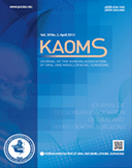Journal of the Korean Association of Oral and Maxillofacial Surgeons
- P-ISSN2234-7550
- E-ISSN2234-5930
- SCOPUS, KCI, ESCI
 ISSN : 2234-7550
ISSN : 2234-7550
Measurement of mandibular lingula location using cone-beam computed tomography and internal oblique ridge-guided inferior alveolar nerve block
Seung-Jung Han (CGBio Research Center, Seongnam)
Abstract
Objectives: Inferior alveolar nerve block (IANB) is the most frequently used treatment for mandibular molars. Successful IANB requires insertion of the dental needle near the mandibular foramen. In this study, we aimed to analyze the anatomic location of the mandibular lingula and evaluate the effects of internal oblique ridge (IOR)-guided IANB. Materials and Methods: The location of the mandibular lingula was measured using cone-beam computed tomography images of the mandibles obtained from 125 patients. We measured the distances from the occlusal plane to the lingula and from the IOR to the lingula in 250 mandibular rami. Based on the mean of these distances, alternative anesthesia was carried out on 300 patients, and the success rate of the technique was evaluated. Results: The mean vertical distance was 8.85±2.59 mm, and the mean horizontal distance was 14.68±1.44 mm. The vertical (P<0.001) and the horizontal (P<0.05) distances showed significant differences between the sex groups. The success rate of the IOR-guided technique was 97.3%. Conclusion: IANB-based location of mandibular lingula showed a high success rate. From this study, we concluded that analysis of the anatomic locations for mandibular lingula and IOR-guided IANB are useful for restorative and surgical dental procedures of the mandibular molars.
- keywords
- Inferior alveolar nerve, Inferior alveolar nerve block, Lingula, Mandibular foramen, Internal oblique ridge
- Downloaded
- Viewed
- 0KCI Citations
- 0WOS Citations